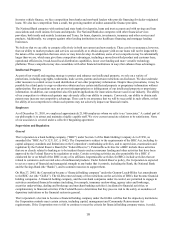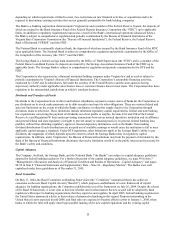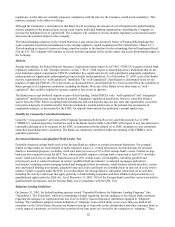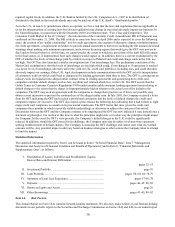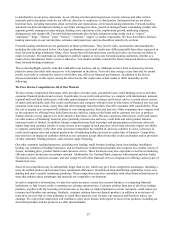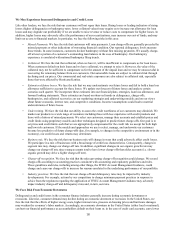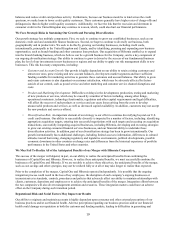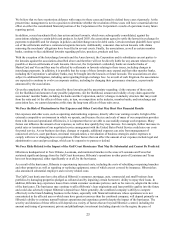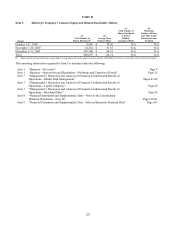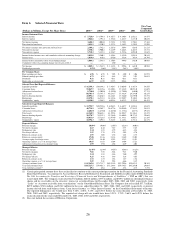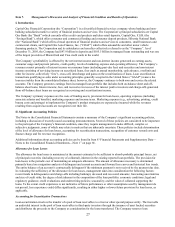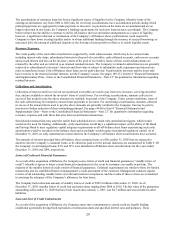Capital One 2005 Annual Report Download - page 28
Download and view the complete annual report
Please find page 28 of the 2005 Capital One annual report below. You can navigate through the pages in the report by either clicking on the pages listed below, or by using the keyword search tool below to find specific information within the annual report.balances and reduce credit card purchase activity. Furthermore, because our business model is to lend across the credit
spectrum, we make loans to lower credit quality customers. These customers generally have higher rates of charge-offs and
delinquencies than do higher credit quality customers. Additionally, we face the risk that the recession and downturn in
onsumer credit in the United Kingdom may continue to worsen, which, could also hurt our financial performance. c
W
e Face Strategic Risks in Sustaining Our Growth and Pursuing Diversification
Our growth strategy has multiple components. First, we seek to continue to grow our established businesses, such as our
domestic credit card and automobile finance businesses. Second, we hope to continue to diversify our business, both
geographically and in product mix. We seek to do this by growing our lending businesses, including credit cards,
internationally, principally in the United Kingdom and Canada, and by identifying, pursuing and expanding new business
opportunities, such as branch banking and other consumer loan products. Our acquisition of Hibernia enabled us to expand
into the branch banking business, which we believe can be a growth business for the Company, and is a key component of
our ongoing diversification strategy. Our ability to continue to grow is driven by the success of our fundamental business
plan, the level of our investments in new businesses or regions and our ability to apply our risk management skills to new
usinesses. This risk has many components, including: b
• Customer and Account Growth. Our growth is highly dependent on our ability to retain existing customers and
attract new ones, grow existing and new account balances, develop new market segments and have sufficient
funding available for marketing activities to generate these customers and account balances. Our ability to grow
and retain customers is also dependent on customer satisfaction, which may be adversely affected by factors
outside of our control, such as postal service and other marketing and customer service channel disruptions and
costs.
• Product and Marketing Development. Difficulties or delays in the development, production, testing and marketing
of new products or services, which may be caused by a number of factors including, among other things,
operational constraints, technology functionality, regulatory and other capital requirements and legal difficulties,
will affect the success of such products or services and can cause losses arising from the costs to develop
unsuccessful products and services, as well as decreased capital availability. In addition, customers may not accept
the new products and services offered.
• Diversification Risk. An important element of our strategy is our effort to continue diversifying beyond our U.S.
credit card business. Our ability to successfully diversify is impacted by a number of factors, including: identifying
appropriate acquisition targets, entering into successful negotiations with such targets and executing on acquisition
transactions, successfully integrating acquired businesses, including Hibernia, developing and executing strategies
to grow our existing consumer financial services businesses, and our financial ability to undertake these
diversification activities. In addition, part of our diversification strategy has been to grow internationally. Our
growth internationally faces additional challenges, including limited access to information, differences in cultural
attitudes toward borrowing, changing regulatory and legislative environments, political developments, possible
economic downturns in other countries exchange rates and differences from the historical experience of portfolio
performance in the United States and other countries.
W
e May Fail To Realize All of the Anticipated Benefits of our Merger with Hibernia Corporation.
The success of the merger will depend, in part, on our ability to realize the anticipated benefits from combining the
businesses of Capital One and Hibernia. However, to realize these anticipated benefits, we must successfully combine the
businesses of Capital One and Hibernia. If we are not able to achieve these objectives, the anticipated benefits of the merger,
such as cost savings and other synergies, may not be realized fully or at all or may take longer to realize than expected.
Prior to the completion of the merger, Capital One and Hibernia operated independently. It is possible that the ongoing
integration process could result in the loss of key employees, the disruption of each company’ s ongoing businesses or
inconsistencies in standards, controls, procedures and policies that adversely affect our ability to maintain relationships with
clients, customers, depositors and employees or to achieve the anticipated benefits of the merger. Integration efforts between
the two companies will also divert management attention and resources. These integration matters could have an adverse
effect on the Company during such transition period.
Reputational Risk and Social Factors May Impact our Results
Our ability to originate and maintain accounts is highly dependent upon consumer and other external perceptions of our
business practices and/or our financial health. Adverse perceptions regarding our business practices and/or our financial
health could damage our reputation in both the customer and funding markets, leading to difficulties in generating and
19



